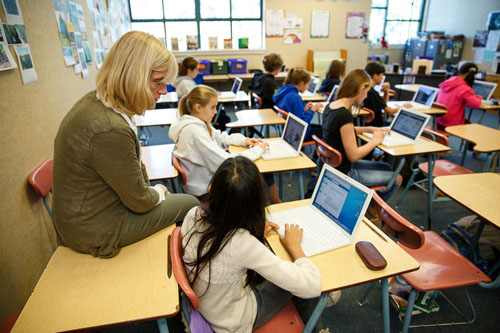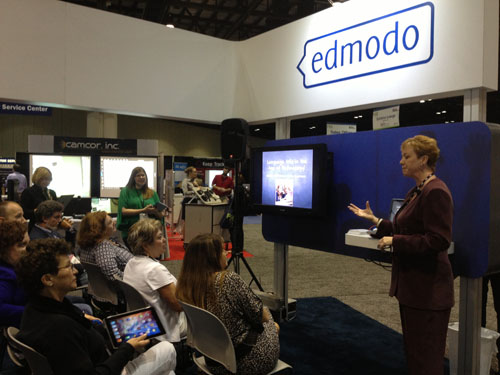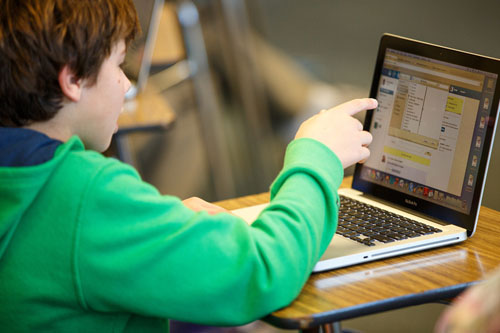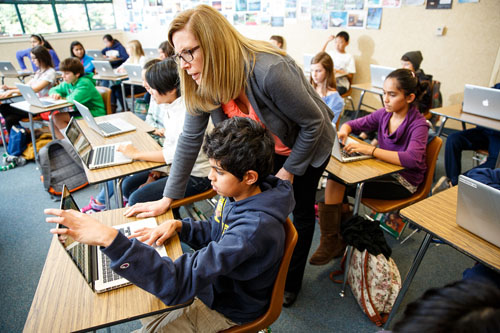
Have you done your Edmodo, honey?
Yes that’s right, I said “Edmodo,” not “homework” or even “school work”.
An impressive 17 million plus users worldwide are doing their Edmodo. The company’s mission since it’s beginnings has been to provide a free and safe platform that allows students and teachers to come together to collaborate and learn.
Think Facebook with a big educational vision that focuses on using many unique technology features to augment what’s already happening in the classroom. New ideas are often introduced and expanded by teachers themselves at the company’s annual teacher conferences; the last one brought together 12,000 professionals from 117 countries. Jennifer Bond, a 3rd grade teacher at Walled Lake Consolidated Schools in Walled Lake, Michigan, has been using Edmodo extensively for years and says she likes it because it is “education minded”. Jennifer is actively involved in the Edmodo Global Read Aloud, which she says “can be challenging with time zones and scheduling video conferences, but the pros are that the kids have the opportunity to connect with kids from all over the world and gain new perspectives.”

Does Edmodo’s Digital Citizen Starter Kit handle the challenge of educating kids to be good digital citizens? The answer is “Yes!” according to Bianca Hewes, a high school English teacher in Sydney, Australia who’s also been doing awesome things with Edmodo since 2009 (including connecting 30 of her students with registered Edmodo teachers in the US, South America and England to mentor their individual writing projects). “Edmodo is a social network with training wheels,” says Bianca. “By introducing it at a young age, teachers are able to develop the habits of the mind that are essential for students to be good digital citizens. Students learn to use appropriate language, to speak kindly and with compassion, to be supportive rather than critical, and to ask thoughtful questions.”
I had the opportunity to chat further with the Company’s COO, Crystal Hutter.

How is Edmodo helping to address the achievement gap? Isn’t the lack of computers and bandwidth a significant impediment?
We see our opportunity as being able to connect teachers and classrooms around the world to create a powerful network of learners so that all of the best ideas and resources can surface. With Edmodo, teachers can discover content in real time and deliver it in a personalized way to their students. For example, teachers can receive instant feedback on how his/her students perform by giving them a quiz on Edmodo and getting real time analytics to see how each student is grasping the material. She can put students into small groups where each group gets different content or different instructional materials to ensure that every single student in her classroom learns the concept that she is teaching that day.
Have you come across limitations of low-income families in affording good quality computers and satisfactory Internet access to use Edmodo? My concern is that this would be a significant impediment to students in low-income families.
Every district and school handles access to technology differently. Many schools are starting to adopt “BYOD” (Bring Your Own Device) environments, where each student is allowed to bring in their own mobile devices to use in class. Some schools have laptop or iPad carts that teachers share amongst their classrooms. Other schools have computer labs that students can access at specific hours during and after school.
While not every student has access to a computer, most do have access to a mobile device in their household. Edmodo offers a mobile website and native apps for iOS and Android devices.

I see Edmodo as a platform with resources that could also be helpful in classrooms where learning has been more challenging. If every poor child in the US had access to Edmodo, what impact could it have on our domestic achievement gap?
The demographics of Edmodo in the US, which is about 75% of our users, mirrors the demographics of the US K-12 system, covering everything from grade level to subject area and from rural to urban, high income to low income as well as public versus private. I think it’s important that Edmodo has been a platform that can be adapted to any type of classroom in the US and in every part of the world. We already have over 17,000,000 users. Teachers have been an important part of creating a real change in their classrooms by being a part of this global network and by engaging their students in it as well.
If students are doing so nicely with Edmodo, why not just home school them?
Every student and family has a different need and approach and we support all of those environments. I was recently talking to a woman who home schools her son. He is extremely gifted and takes a large number of courses. She spends a massive amount of time curating his courses, which involves using many different platforms with varying levels of technology. So she brings all these courses and all of his tutors onto Edmodo and this has made her process much more manageable. She also feels now like she’s not a lonely island because she’s connecting with other teachers who have great ideas. So whether you are a Mom curating your child’s lessons at home or a teacher in a classroom, the idea is to make sure that you don’t feel like you’re on a lonely island but that you are part of a much broader community.

Can social interaction in an online environment ever be quite the same as social interaction in a classroom?
For us it is always about the blend of offline and online. What teachers on Edmodo do so well is combine the best of the tried and true of pedagogy in the classroom with new digital applications and technologies that are coming online. It’s all about making sure the offline and the online worlds are seamless so that you create the best personalized learning experiences for students. We are social creatures and learning is a social experience but we see that every student is different. We hear stories from teachers about students, for example, a student who was not as vocal in class, so the question was, “Is she/he really engaged in the learning process?” The teacher has told us that Edmodo has really taken a leadership role in helping that student to find his/her voice.
Do you find that teachers are happy to share their content with other teachers around the world?
Yes, the vast majority of teachers that we meet are. There are teachers who spend up to 40 hours developing a lesson to teach to students. If a teacher can feel that by sharing that lesson with the Edmodo community she will be able to get amazing feedback from other teachers and that it may have impacted the lives of many more students, that’s important. Teachers are teachers because they want to change the lives of students, so Edmodo allows them to be able to do that on a whole new scale with students and with their fellow teachers.

Great to hear that – I know that encouraging more teachers to share their multi-media lessons has been challenging for the Wikiwijs platform in The Netherlands.
I think the difference with our platform is that teachers are on Edmodo every single day teaching their students so it becomes second nature to them to share. For example, while they’re on it they may have a question for the community and another teacher may immediately respond with, “Here’s what I did.” Real-time is much easier and I think it allows for all types of things to be shared. There is an app on Edmodo called NoRedInk (a fun way to practice and master grammar and writing skills). It was built by a language arts teacher at this time last year and it actually went viral on Edmodo.
Edmodo is a free learning platform. Where do the revenues come from in this model?
Edmodo is free for teachers and students and always will be. In March 2012, we opened our API to educational publishers to enable them create web-based apps for the platform. These free and paid apps integrate with the features of Edmodo and enable teachers to streamline all the educational tools and resources they use with their students in one place (Edmodo).
Five to ten years from now – where do you see Edmodo?
Edmodo will continue to be the place where learning happens, connecting teachers and students around the world to the resources and tools that will help them reach their full potential.

Photos courtesy of Edmodo.
In The Global Search for Education, join me and globally renowned thought leaders including Sir Michael Barber (UK), Dr. Michael Block (U.S.), Dr. Leon Botstein (U.S.), Professor Clay Christensen (U.S.), Dr. Linda Darling-Hammond (U.S.), Dr. Madhav Chavan (India), Professor Michael Fullan (Canada), Professor Howard Gardner (U.S.), Professor Andy Hargreaves (U.S.), Professor Yvonne Hellman (The Netherlands), Professor Kristin Helstad (Norway), Jean Hendrickson (U.S.), Professor Rose Hipkins (New Zealand), Professor Cornelia Hoogland (Canada), Honourable Jeff Johnson (Canada), Mme. Chantal Kaufmann (Belgium), Dr. Eija Kauppinen (Finland), State Secretary Tapio Kosunen (Finland), Professor Dominique Lafontaine (Belgium), Professor Hugh Lauder (UK), Professor Ben Levin (Canada), Lord Ken Macdonald (UK), Professor Barry McGaw (Australia), Shiv Nadar (India), Professor R. Natarajan (India), Dr. Pak Tee Ng (Singapore), Dr. Denise Pope (US), Sridhar Rajagopalan (India), Dr. Diane Ravitch (U.S.), Richard Wilson Riley (U.S.), Sir Ken Robinson (UK), Professor Pasi Sahlberg (Finland), Andreas Schleicher (PISA, OECD), Dr. Anthony Seldon (UK), Dr. David Shaffer (U.S.), Dr. Kirsten Sivesind (Norway), Chancellor Stephen Spahn (U.S.), Yves Theze (Lycee Francais U.S.), Professor Charles Ungerleider (Canada), Professor Tony Wagner (U.S.), Sir David Watson (UK), Professor Dylan Wiliam (UK), Dr. Mark Wormald (UK), Professor Theo Wubbels (The Netherlands), Professor Michael Young (UK), and Professor Minxuan Zhang (China) as they explore the big picture education questions that all nations face today. The Global Search for Education Community Page
C. M. Rubin is the author of two widely read online series for which she received a 2011 Upton Sinclair award, “The Global Search for Education” and “How Will We Read?” She is also the author of three bestselling books, including The Real Alice in Wonderland.

Recent Comments